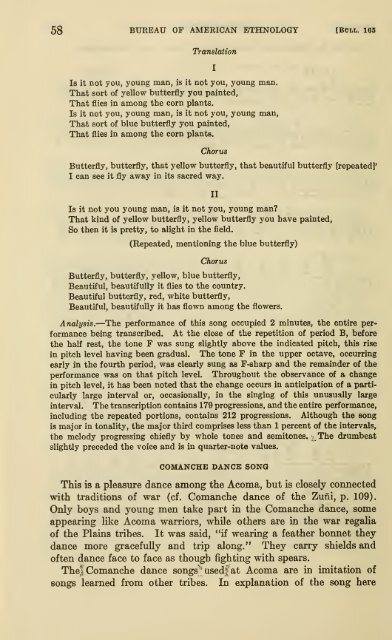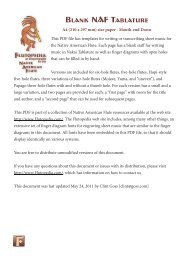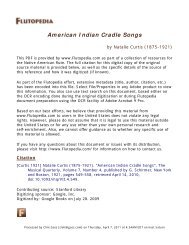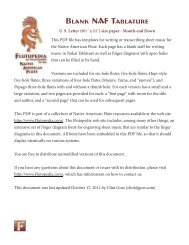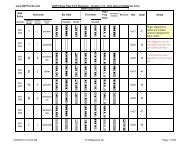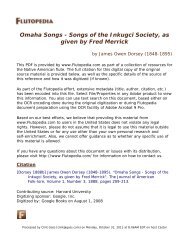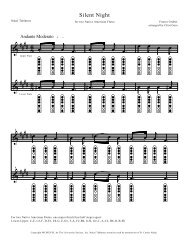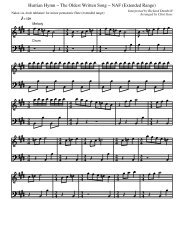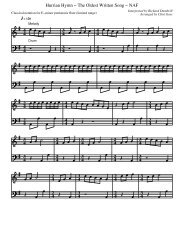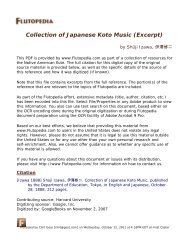Music of Acoma, Isleta, Cochiti, and Zuñi Pueblos - Flutopedia.com
Music of Acoma, Isleta, Cochiti, and Zuñi Pueblos - Flutopedia.com
Music of Acoma, Isleta, Cochiti, and Zuñi Pueblos - Flutopedia.com
Create successful ePaper yourself
Turn your PDF publications into a flip-book with our unique Google optimized e-Paper software.
58 BUREAU OF AMERICAN ETHNOLOGY [Boll. 165<br />
Translation<br />
Is it not you, young man, is it not you, young man.<br />
That sort <strong>of</strong> yellow butterfly you painted,<br />
That flies in among the corn plants.<br />
Is it not you, young man, is it not you, young man,<br />
That sort <strong>of</strong> blue butterfly you painted,<br />
That flies in among the corn plants.<br />
Chortis<br />
Butterfly, butterfly, that yellow butterfly, that beautiful butterfly [repeated]'<br />
I can see it fly away in its sacred way.<br />
Is it not you young man, is it not you, young man?<br />
That kind <strong>of</strong> yellow butterfly, yellow butterfly you have painted,<br />
So then it is pretty, to alight in the field.<br />
II<br />
(Repeated, mentioning the blue butterfly)<br />
Chorus<br />
Butterfly, butterfly, yellow, blue butterfly,<br />
Beautiful, beautifully it flies to the country.<br />
Beautiful butterfly, red, white butterfly,<br />
Beautiful, beautifully it has flown among the flowers.<br />
Analysis.—The performance <strong>of</strong> this song occupied 2 minutes, the entire performance<br />
being transcribed. At the close <strong>of</strong> the repetition <strong>of</strong> period B, before<br />
the half rest, the tone F was sung slightly above the indicated pitch, this rise<br />
in pitch level having been gradual. The tone F in the upper octave, occurring<br />
early in the fourth period, was clearly sung as F-sharp <strong>and</strong> the remainder <strong>of</strong> the<br />
performance was on that pitch level. Throughout the observance <strong>of</strong> a change<br />
in pitch level, it has been noted that the change occurs in anticipation <strong>of</strong> a particularly<br />
large interval or, occasionally, in the singing <strong>of</strong> this unusually large<br />
interval. The transcription contains 179 progressions, <strong>and</strong> the entire performance,<br />
including the repeated portions, contains 212 progressions. Although the song<br />
is major in tonality, the major third <strong>com</strong>prises less than 1 percent <strong>of</strong> the intervals,<br />
the melody progressing chiefly by whole tones <strong>and</strong> semitones. ^The drimibeat<br />
slightly preceded the voice <strong>and</strong> is in quarter-note values.<br />
COMANCHE DANCE SONG<br />
This is a pleasure dance among the <strong>A<strong>com</strong>a</strong>, but is closely connected<br />
with traditions <strong>of</strong> war (cf. Comanche dance <strong>of</strong> the Zuni, p. 109).<br />
Only boys <strong>and</strong> young men take part in the Comanche dance, some<br />
appearing like <strong>A<strong>com</strong>a</strong> warriors, while others are in the war regalia<br />
<strong>of</strong> the Plains tribes. It was said, "if wearing a feather bonnet they<br />
dance more gracefully <strong>and</strong> trip along." They carry shields <strong>and</strong><br />
<strong>of</strong>ten dance face to face as though fighting with spears.<br />
The| Comanche dance songs 'usedf at <strong>A<strong>com</strong>a</strong> are in imitation <strong>of</strong><br />
songs learned from other tribes. In explanation <strong>of</strong> the song here


